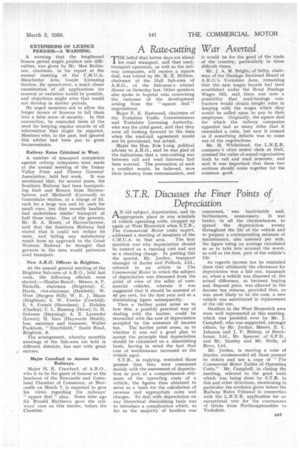S.T.R. Discusses the Finer Points of Depreciation Fr .
Page 53

If you've noticed an error in this article please click here to report it so we can fix it.
A' old subject, depreciation, and its appropriate place in any schedule of vehicle operating costs, cropped up again at West Bromwich when S.T.R„ The Commercial Motor costs expert, , addressed a meeting of members of the C.M.U.A. in that area. The first question was why depreciation should he treated as a running cost and not as a standing charge. In putting this the querist, Mr. Jordan, transport manager Of Accles and Pollock, Ltd., referred to an article in The Commercial Motor in which the subject of depreciation was discussed from the point of view of the seller of commercial vehicles, wherein it was suggested that it should be assessed at 40 per cent, for the first year and at a diminishing figure subsequently.
Then a further point arose as to how this, a possibly practical way of dealing with the matter, could be reconciled with the rate of depreciation • accepted by the assessors of income tax. The further point arose, as to whether it was not a good plan to accept the principle that depreciation should .be calculated on a diminishing basis, having in mind the fact that cost of maintenance increased as the vehicle aged.
S.T.R., in replying, reminded those present that they were concerned mainly with the assessment of depreciation as part of a comprehensive estimate of the operating costs of a vehicle, the figures thus obtained to serve as a basis for the calculation of revenue and appropriate rates and charges. To deal with depreciation on any theoretical diminishing basis was to introduce a complication which, so far as the majority' of hauliers was concerned, was inadvisable and, furthermore, unnecessary. It was better, in all the circumstances, to spread the depreciation evenly throughout the life of the vehicle and to prepare a corresponding estimate of maintenance, also assessed per mile, the figure being an average calculated so as to take into account the worst, as well as the best, part of the vehicle's life.'
As regards income tax he reminded them that ultimately the allowance for depreciation was a fair one, inasmuch as, when a vehicle was disposed of, the actual difference, as between buying and disposal price, was allowed in the income tax returns, provided that, as was most likely to be the case, a new vehicle was substituted in replacement of the old one.
Hauliers in the West Bromwich area were well represented at this meeting, which was presided over by Mr. J. Campbell, who was supported, amongst others, by Mr. Jordan, Messrs. E. C. Johnson and J. F. Bishop, of Brockhouse, Ltd., Mr. Spencer, of S.P.D„ and Mr. Stanley and Mr. Wells, of Revo, Ltd.
Mr. Jordan, in moving a vote of thanks, recommended all those present to obtain and use a copy of " The Commercial Motor Tables of Operating • Costs." Mr. Campbell, in closing the meeting, referred to the good work which was being done by S.T.R. in this and other directions, mentioning in particular the evidence given before the Railway Rates Tribunal in connection with the L.N.E.R. application for an exceptional rate for the conveyance (If bricks from Northamptonshire to Yorkshire.




















































































